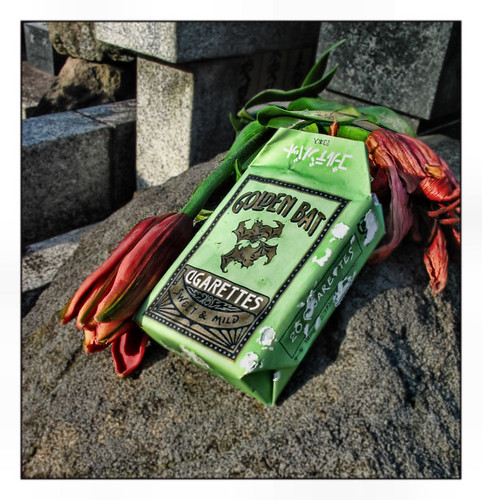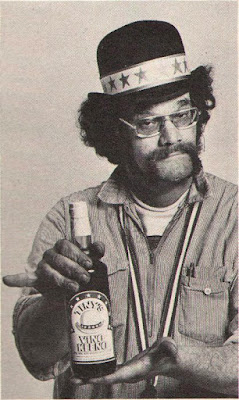Golden Bats
The first bats of the season appeared this week. Flitting above the Zenpukijigawa, a few brave furry fliers tested out the warm spring air, darting hither and yon, daintily devouring insects. It's a welcome sight here in Tokyo. Sakura blossoming means that spring is coming. Bats mean that spring is here. Seeing these super-signifying flying mammals made me think of the archetypical Japanese smoke, Golden Bats.
Oh, wait... it's been a few months since I wrote those last few words. We're nearly through the doldrums of another hot and sticky summer. The bats are now out in force. Last night at twilight, the sky was heavily peppered with bats, the air buzzed with drill of cicadas. And boy, do I need a cigarette.
 Golden Bats (Ogon Batto) are the grandaddies of Japanese cigarettes. In 1904, the Japan Tobacco, the state-run tobacco monopoly, was formed and by 1906 the flagship brand of Golden Bats was introduced to the public. They are still being made with their distinctive green packages and pair o' bats design, somewhat compromised these days by the oversized health warning labels. They're a classic non-filter smoke, akin to Luckies. And they are cheap! Japanese cigs are one of the few bargains to be had in the land of the rising sun, but Golden Bats are a true steal at about 180 yen a pack. That's about a buck and a half! Rumor had it that Golden Bats were made of the leftover leaf ends from the manufacture of other brands of cigarettes, making them either really great - if you got some from the batch made with premium cigarettes - or really horrible - if you were just unlucky. But the truth is they are made from a strict formula and like most contemporary cigarettes generally designed to deliver nicotine and tar, rather than taste.
Golden Bats (Ogon Batto) are the grandaddies of Japanese cigarettes. In 1904, the Japan Tobacco, the state-run tobacco monopoly, was formed and by 1906 the flagship brand of Golden Bats was introduced to the public. They are still being made with their distinctive green packages and pair o' bats design, somewhat compromised these days by the oversized health warning labels. They're a classic non-filter smoke, akin to Luckies. And they are cheap! Japanese cigs are one of the few bargains to be had in the land of the rising sun, but Golden Bats are a true steal at about 180 yen a pack. That's about a buck and a half! Rumor had it that Golden Bats were made of the leftover leaf ends from the manufacture of other brands of cigarettes, making them either really great - if you got some from the batch made with premium cigarettes - or really horrible - if you were just unlucky. But the truth is they are made from a strict formula and like most contemporary cigarettes generally designed to deliver nicotine and tar, rather than taste.
 However, Golden Bats have perennially been a favorite choice of cancer for generations of Bohemians. Photo documents of writers such as Yukio Mishima and Osamu Dazai with smokes in hand offer proof. Both Mishima and Dazai managed to beat death by cigarette by taking control of their own destinies and committing suicide. To this day at Dazai's grave in Mitaka, devotees often leave packages of Golden Bats as remembrance offerings.
However, Golden Bats have perennially been a favorite choice of cancer for generations of Bohemians. Photo documents of writers such as Yukio Mishima and Osamu Dazai with smokes in hand offer proof. Both Mishima and Dazai managed to beat death by cigarette by taking control of their own destinies and committing suicide. To this day at Dazai's grave in Mitaka, devotees often leave packages of Golden Bats as remembrance offerings.
 Golden Bats (Ogon Batto) are the grandaddies of Japanese cigarettes. In 1904, the Japan Tobacco, the state-run tobacco monopoly, was formed and by 1906 the flagship brand of Golden Bats was introduced to the public. They are still being made with their distinctive green packages and pair o' bats design, somewhat compromised these days by the oversized health warning labels. They're a classic non-filter smoke, akin to Luckies. And they are cheap! Japanese cigs are one of the few bargains to be had in the land of the rising sun, but Golden Bats are a true steal at about 180 yen a pack. That's about a buck and a half! Rumor had it that Golden Bats were made of the leftover leaf ends from the manufacture of other brands of cigarettes, making them either really great - if you got some from the batch made with premium cigarettes - or really horrible - if you were just unlucky. But the truth is they are made from a strict formula and like most contemporary cigarettes generally designed to deliver nicotine and tar, rather than taste.
Golden Bats (Ogon Batto) are the grandaddies of Japanese cigarettes. In 1904, the Japan Tobacco, the state-run tobacco monopoly, was formed and by 1906 the flagship brand of Golden Bats was introduced to the public. They are still being made with their distinctive green packages and pair o' bats design, somewhat compromised these days by the oversized health warning labels. They're a classic non-filter smoke, akin to Luckies. And they are cheap! Japanese cigs are one of the few bargains to be had in the land of the rising sun, but Golden Bats are a true steal at about 180 yen a pack. That's about a buck and a half! Rumor had it that Golden Bats were made of the leftover leaf ends from the manufacture of other brands of cigarettes, making them either really great - if you got some from the batch made with premium cigarettes - or really horrible - if you were just unlucky. But the truth is they are made from a strict formula and like most contemporary cigarettes generally designed to deliver nicotine and tar, rather than taste.Another great story around the Bats is that during Japan’s occupation of Manchuria in the 1930s, Golden Bats were sold to the local population heroin-spiked, to keep them docile on off-kilter. A rather sinister idea, that lends a certain frisson - outlaw cred and reprobate nationalism together at last - to these cigarettes in particular.
 However, Golden Bats have perennially been a favorite choice of cancer for generations of Bohemians. Photo documents of writers such as Yukio Mishima and Osamu Dazai with smokes in hand offer proof. Both Mishima and Dazai managed to beat death by cigarette by taking control of their own destinies and committing suicide. To this day at Dazai's grave in Mitaka, devotees often leave packages of Golden Bats as remembrance offerings.
However, Golden Bats have perennially been a favorite choice of cancer for generations of Bohemians. Photo documents of writers such as Yukio Mishima and Osamu Dazai with smokes in hand offer proof. Both Mishima and Dazai managed to beat death by cigarette by taking control of their own destinies and committing suicide. To this day at Dazai's grave in Mitaka, devotees often leave packages of Golden Bats as remembrance offerings.Golden Bats have developed a great lore and hark back to a somewhat more nostalgic time, when things such as drinking, smoking, and living were judged a little less harshly and the interdictions against them were a bit more benign. However, you can still find some interesting propaganda on the positive side of slow death at the Tobacco and Salt Museum in Shibuya. Japan Tabacco runs this museum, documenting in loving detail, history, package and poster design, and lore about smoking. It also has a space for changing exhibitions. Most recently the Ajimi team saw a photo show on stimulants throughout the world. Coffee, tea, betel nuts, and khat use were lusciously documented in oversize photographs. But when you're at the museum, there's no smoking allowed. You can go outside, though, and huff down that Golden Bat in a special designated smoking section.
NV


Comments